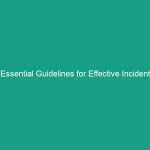Introduction
Good morning team! Today, we’re diving into an essential topic that affects all of us as we navigate the world of remote work: Essential Working From Home Guidelines: Avoid Common Safety Risks. With the rise of telecommuting, it’s crucial to ensure that our home workspaces are as safe as our traditional office environments. Understanding the potential risks and how to mitigate them can help us all stay productive and healthy.
Understanding Essential Working From Home Guidelines
When we talk about “Essential Working From Home Guidelines,” we are referring to the protocols and Best Practices that help ensure a safe and efficient work Environment at home. These guidelines are vital because they address the unique challenges remote workers face, such as ergonomics, mental health, and workplace distractions. It’s a common misconception that working from home is inherently less risky than working in an office, but that’s not the case. In fact, without proper guidelines, employees may face physical and mental health issues that can impact their work performance and overall well-being.
Key Hazards, Risks, and Safety Considerations
While working from home, several Hazards and risks can arise. Here are some key considerations:
- Ergonomic Risks: Poor workstation setup can lead to musculoskeletal issues, such as back pain, neck strain, and repetitive strain injuries.
- Electrical Safety: Overloaded circuits and improper use of extension cords can lead to Electrical Hazards.
- Distractions: Household chores, family members, or pets can divert attention, increasing the risk of accidents and decreasing productivity.
- Mental Health Challenges: Isolation and lack of interaction can lead to anxiety and depression, affecting overall job performance.
Ignoring these risks can have real-world consequences, such as chronic pain, decreased productivity, and increased stress levels. It’s crucial to address these issues proactively to maintain a safe working environment.
Best Practices, Procedures, & Actionable Advice
To enhance your safety while working from home, consider these Best Practices:
1. Set Up an Ergonomic Workspace
Your home office should be designed to promote comfort and productivity. Here are some tips:
- Ensure your chair supports your lower back and allows your feet to rest flat on the floor.
- Position your computer screen at eye level to avoid straining your neck.
- Use a separate keyboard and mouse to maintain a comfortable arm position.
- Take regular breaks to stretch and move around to prevent stiffness.
2. Ensure Electrical Safety
Electrical safety is paramount in a home office. Follow these guidelines:
- Avoid overloading outlets and use surge protectors for your devices.
- Check that all cords are in good condition and replace any that are frayed or damaged.
- Keep cords organized and out of walkways to prevent tripping hazards.
3. Manage Distractions
Staying focused can be challenging when working from home. Here are some strategies:
- Create a designated work area that is free from distractions.
- Set specific working hours and communicate them to family members.
- Use techniques like the Pomodoro Technique to maintain focus and productivity.
4. Prioritize Mental Health
Taking care of your mental health is just as important as your physical safety. Consider the following:
- Schedule regular breaks to disconnect from work and recharge.
- Engage in social interactions, whether through video calls or virtual coffee breaks with colleagues.
- Practice mindfulness or meditation to reduce stress and improve your focus.
Case Study: Real-World Incident
To illustrate the importance of these guidelines, consider the case of an employee who experienced severe back pain due to an improper workstation setup. Despite being a high performer, the employee’s productivity declined as the pain became chronic. After implementing ergonomic adjustments and taking regular breaks, the employee not only alleviated the pain but also saw a significant improvement in productivity.
Regulations, Standards, and Compliance
It’s important to remember that working from home does not exempt us from following safety Regulations. Guidelines from organizations such as OSHA (Occupational Safety and Health Administration) provide a framework for maintaining safe work environments, even at home. Compliance with these Standards is crucial, as it helps protect employees from hazards and ensures that organizations maintain a culture of safety.
Employee Engagement & Discussion
As we wrap up, I want to encourage you all to think about your own home working environments. What safety challenges have you encountered related to working from home? How have you addressed them? Let’s discuss and share our experiences to foster a safer and more productive remote working culture.
Conclusion & Key Takeaways
In conclusion, adhering to the Essential Working From Home Guidelines is vital for avoiding common safety risks. By setting up an ergonomic workspace, ensuring electrical safety, managing distractions, and prioritizing mental health, we can create a safer and more productive work environment. Remember, safety is everyone’s responsibility, and by applying these practices, we can protect ourselves and enhance our work performance.
Thank you for your attention today! Let’s continue to prioritize safety in our remote workspaces and support each other in these efforts.


